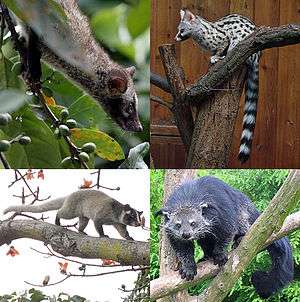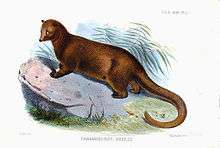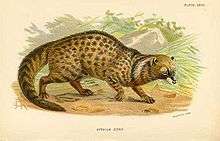Viverridae
| Viverridae[1] Temporal range: 34–0 Ma | |
|---|---|
 | |
| Viverrids, including (top left to bottom right), species of Paradoxurus, Genetta, Paguma and Arctictis | |
| Scientific classification | |
| Kingdom: | Animalia |
| Phylum: | Chordata |
| Class: | Mammalia |
| Order: | Carnivora |
| Suborder: | Feliformia |
| Family: | Viverridae Gray, 1821 |
| Subfamilies | |
Viverridae is a family of small to medium-sized mammals, the viverrids (/vaɪˈvɛrɪdz/), comprising 15 genera, which are subdivided into 38 species.[1] This family was named and first described by John Edward Gray in 1821.[3] Members of this family are commonly called civets or genets. Viverrids are found in South and Southeast Asia, across the Wallace Line, all over Africa, and into southern Europe. Their occurrence in Sulawesi and in some of the adjoining islands shows them to be ancient inhabitants of the Old World tropics.[4]
Characteristics
Viverrids have four or five toes on each foot and half-retractile claws. They have six cutting teeth in each jaw and true grinders with two tubercular grinders behind in the upper jaw, and one in the lower jaw. The tongue is rough with sharp prickles. A pouch or gland occurs beneath the anus, but there is no coecum.[3]
Viverrids are the most primitive of all the families of feliform Carnivora and clearly less specialized than the Felidae (cats). In external characters, they are distinguished from the Felidae by the hind foot being five-toed owing to the invariable presence of the first digit, by the retention of the interramal tuft of facial vibrissae, and typically by the longer muzzle and shorter limbs. The skull differs by the position of the postpalatine foramina on the maxilla, almost always well in advance of the maxillopalatine suture, and usually about the level of the second premolar; and by the distinct external division of the auditory bulla into its two elements either by a definite groove or, when rarely this is obliterated, by the depression of the tympanic bone in front of the swollen entotympanic. The typical dental formula is: 3.1.4.23.1.4.2, but the number may be reduced, although never to the same extent as in the Felidae.[4]
Their flesh-shearing carnassial teeth are relatively undeveloped.[5]
Most viverrid species have a baculum.[6]
Viverrids range in size from the African linsang with a body length of 33 cm (13 in) and a weight of 650 g (1.43 lb) to the African civet at 84 cm (33 in) and 18 kg (40 lb), although very large binturongs, which can weigh up to 25 kg (55 lb), attain the greatest mass.
Ecology and behavior
They are generally solitary and have excellent hearing and vision. They are omnivorous, or, in the case of the palm civet, almost entirely herbivorous.[5]
Favored habitats include woodland, savanna, mountains, and above all, tropical rainforest. Due to heavy deforestation, many are faced with severe loss of habitat; several species are considered vulnerable such as the rare Hose's palm civet, which is endemic to northern Borneo; the otter civet is classified as endangered.[1]
Classification






In 1821, Gray defined this family as consisting of the genera Viverra, Genetta, Herpestes, and Suricata.[3] Reginald Innes Pocock later redefined the family as containing a great number of highly diversified genera, and being susceptible of division into several subfamilies, based mainly on the structure of the feet and of some highly specialized scent glands, derived from the skin, which are present in most of the species and are situated in the region of the external generative organs. He subordinated the subfamilies Hemigalinae, Paradoxurinae, Prionodontinae, and Viverrinae to the Viverridae.[4]
The Viverridae consist of:[1]
- Hemigalinae
- Genus Chrotogale
- Owston's palm civet (Chrotogale owstoni)
- Genus Cynogale
- Otter civet (Cynogale bennettii)
- Genus Diplogale
- Hose's palm civet (Diplogale hosei)
- Genus Hemigalus
- Banded palm civet (Hemigalus derbyanus)
- Genus Chrotogale
- Paradoxurinae
- Genus Arctictis
- Binturong (Arctictis binturong)
- Genus Arctogalidia
- Small-toothed palm civet (Arctogalidia trivirgata)
- Genus Macrogalidia
- Sulawesi palm civet (Macrogalidia musschenbroekii)
- Genus Paguma
- Masked palm civet (Paguma larvata)
- Genus Paradoxurus
- Asian palm civet (Paradoxurus hermaphroditus) (Pallas, 1778)
- Golden palm civet (Paradoxurus zeylonensis) (Pallas, 1778)
- Golden wet-zone palm civet (Paradoxurus aureus) (Cuvier, 1822)
- Sri Lankan brown palm civet (Paradoxurus montanus) (Kelaart, 1852)
- Jerdon's palm civet (Paradoxurus jerdoni) (Blanford, 1885)
- Golden dry-zone palm civet (Paradoxurus stenocephalus) (Groves, 2009)[7]
- Genus Arctictis
- Prionodontinae (see below)
- Genus Prionodon
- Banded linsang (Prionodon linsang)
- Spotted linsang (Prionodon pardicolor)
- Genus Prionodon
- Viverrinae
- Genus Civettictis
- African civet (Civettictis civetta)
- Genus Genetta
- Abyssinian genet (Genetta abyssinica)
- Angolan genet (Genetta angolensis)
- Bourlon's genet (Genetta bourloni)
- Crested servaline genet (Genetta cristata)
- Common genet (Genetta genetta)
- Johnston's genet (Genetta johnstoni)
- Rusty-spotted genet (Genetta maculata)
- Pardine genet (Genetta pardina)
- Aquatic genet (Genetta piscivora)
- King genet (Genetta poensis)
- Servaline genet (Genetta servalina)
- Haussa genet (Genetta thierryi)
- Cape genet (Genetta tigrina)
- Giant forest genet (Genetta victoriae)
- Genus Poiana
- Leighton's linsang (Poiana leightoni)
- African linsang (Poiana richardsonii)
- Genus Viverra
- Malabar large-spotted civet (Viverra civettina)
- Large-spotted civet (Viverra megaspila)
- Malayan civet (Viverra tangalunga)
- Large Indian civet (Viverra zibetha)
- Genus Viverricula
- Small Indian civet (Viverricula indica)
- Genus Civettictis
Some authorities are of the opinion that the subfamily Prionodontinae, which consists of two extant species of Asiatic linsangs in the genus Prionodon, should be regarded as a family in its own right.[8]
In 1833, Edward Turner Bennett described the Malagasy fossa (Cryptoprocta ferox) and subordinated the Cryptoprocta to the Viverridae.[9] A molecular and morphological analysis based on DNA/DNA hybridization experiments suggests that Cryptoprocta does not belong within Viverridae, but is a member of the Eupleridae.[10]
The African palm civet (Nandinia binotata) resembles the civets of the Viverridae, but is genetically distinct and belongs in its own monotypic family, the Nandiniidae. There is little dispute that the Poiana species are viverrids.[1]
References
- 1 2 3 4 5 Wozencraft, W.C. (2005). "Order Carnivora". In Wilson, D.E.; Reeder, D.M. Mammal Species of the World: A Taxonomic and Geographic Reference (3rd ed.). Johns Hopkins University Press. pp. 548–559. ISBN 978-0-8018-8221-0. OCLC 62265494.
- ↑ Gaubert, P. & Cordiero-Estrela, P. (2006). "Phylogenetic systematics and tempo of evolution of the Viverrinae (Mammalia, Carnivora, Viverridae) within feliformians: implications for faunal exchanges between Asia and Africa". Molecular Phylogenetics and Evolution. 41 (2): 266–278. doi:10.1016/j.ympev.2006.05.034.
- 1 2 3 Gray, J. E. (1821). "On the natural arrangement of vertebrose animals". London Medical Repository. 15 (1): 296–310.
- 1 2 3 Pocock, R. I. (1939). The Fauna of British India, including Ceylon and Burma. Mammalia. – Volume 1. Taylor and Francis, London. Pp. 330–332.
- 1 2 Wozencraft, W. C. (1984). Macdonald, D., ed. The Encyclopedia of Mammals. New York: Facts on File. pp. 134–135. ISBN 0-87196-871-1.
- ↑ Ewer, R. F. (1998). The Carnivores. Cornell University Press. ISBN 0-8014-8493-6.
- ↑ Groves, C. P., Rajapaksha, C., Manemandra-Arachchi, K. (2009). "The taxonomy of the endemic golden palm civet of Sri Lanka" (PDF). Zoological Journal of the Linnean Society. 155: 238–251. doi:10.1111/j.1096-3642.2008.00451.x.
- ↑ Gaubert, P.; Veron, G. (2003). "Exhaustive sample set among Viverridae reveals the sister-group of felids: the linsangs as a case of extreme morphological convergence within Feliformia" (PDF). Proceedings of the Royal Society B: Biological Sciences. 270 (1532): 2523–2530. doi:10.1098/rspb.2003.2521. PMC 1691530
 . PMID 14667345.
. PMID 14667345. - ↑ Bennett, E. T. (1833). "Notice of a new genus of Viverridous Mammalia from Madagascar". Proceedings of the Zoological Society of London. 1833: 46.
- ↑ Veron, G.; Catzeflis, F. M. (1993). "Phylogenetic relationships of the endemic Malagasy carnivore Cryptoprocta ferox (Aeluroideae): DNA/DNA hybridization experiments". Journal of Mammalian Evolution. 1 (3): 169–185. doi:10.1007/bf01024706.
External links
| Wikimedia Commons has media related to Viverridae. |
| Wikispecies has information related to: Viverridae |
- "Genet: Wildlife summary". African Wildlife Foundation.
- BBC: 'New mammal' seen in Borneo
- University of Michigan's Animal Diversity Web page
- ITIS page
- The Straight Dope on Civet Cats